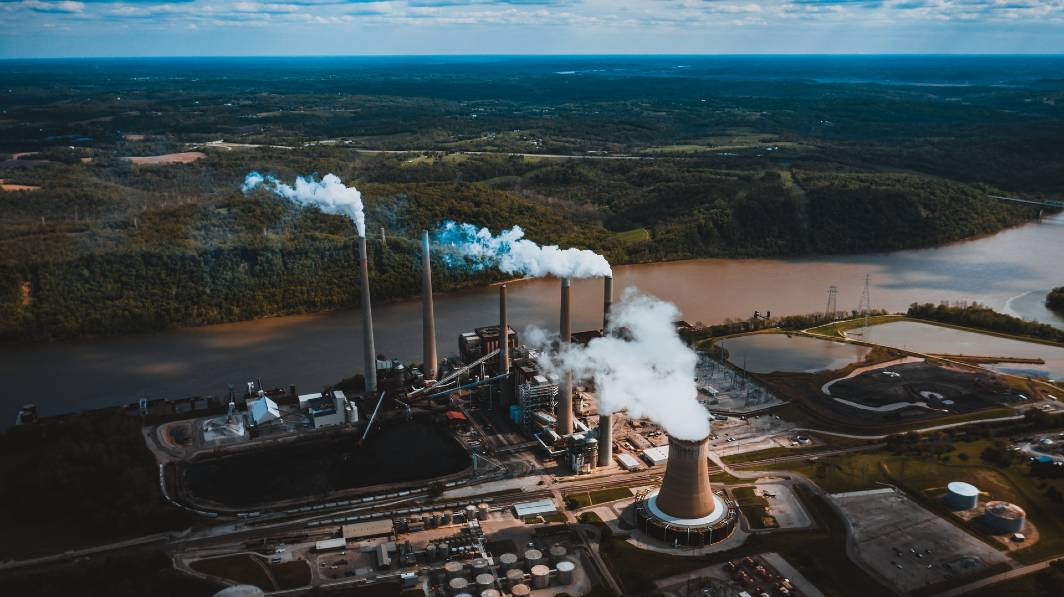This article was reviewed and updated in October 2025.
The UK Emissions Trading Scheme (ETS) has been running since 2021 and the government has been consulting on extending it beyond 2030. Here at the Hub we get a lot of queries about the UK ETS, so we created this FAQ to answer the most common questions. If your question isn’t answered here, get in touch and we’ll do our best to help.
What is the UK Emissions Trading Scheme?
The UK ETS is a system of carbon pricing and trading for UK businesses in energy-intensive sectors. It is run by the governments of the United Kingdom.
What is the point of the UK ETS?
The point of all emissions trading schemes is to reduce overall emissions by putting a price on them, thereby creating a financial incentive to decarbonise. The UK government has a legally binding target to reach net zero emissions by 2050 and the UK ETS is one of the mechanisms it is using to help achieve this.
How does the UK ETS work?
It follows the “cap and trade” approach. A maximum level, or cap, is set on total emissions and trading for participating businesses happens below that ceiling.
In theory, every unit of emissions up to the maximum is part of the system of tradeable allowances. In practice, there is some wiggle room: every participating business gets to emit a certain quantity of carbon that isn’t included in the UK ETS so doesn’t have to be paid for. This is known as the “free allocation”.
In place as of 2024 is a rule that industries in the UK ETS will have to cut emissions at a rate compatible with net zero.
What is the point of free allocations?
Making businesses pay for their carbon emissions is supposed to encourage them to cut carbon and move to greener ways of working. But there’s a risk: when costs increase too much, businesses might respond by moving to countries where they don’t have to pay. That’s bad for the UK economy and does nothing to actually cut emissions. This counterproductive phenomenon is known as “carbon leakage” and it’s a concern for any country or trade bloc when setting climate policy. Free allocations are designed to soften the impact of carbon pricing on UK businesses.
But there is a concern that being too generous with free allocations could undermine the UK ETS in its aim of reducing overall emissions. So the government has to strike a careful balance. There is a predetermined overall ‘pot’ of free allocations and the plan is to gradually reduce the allowance available to businesses up to 2030.
The government has split the administration of free allocations into two periods. This is so it can use data and what it’s learnt from the first period to determine the most effective way of handling the second one. The two periods were originally 2021-2025 and 2026-2030. But the government recently decided to shift the start of the second period from 2026 to 2027, so that free allocations can align with the forthcoming Carbon Border Adjustment Mechanism (CBAM).
The CBAM could be a game-changer because up to now, free allocations have been the government’s main mechanism for avoiding carbon leakage. The CBAM will be another important mitigation mechanism.
Why does the UK have a trading scheme and not just a cap on emissions?
Cap and trade systems like the UK ETS are considered compatible with a free-market economy because they do not seek to control how and where emissions are created. By allocating a financial value to each unit of emissions, it leaves that up to the market. Crucially, every year the overall cap is lowered, which means the cost of emissions allowances goes up and the financial case for decarbonisation gets stronger.
Why does the UK have its own emissions trading scheme?
The UK used to be part of the European Union’s emissions trading system, the EU ETS, but we left it when we left the EU at the end of 2020. The UK ETS is what we created to replace it.
When did the UK ETS start?
It came into force on 1 January 2021, but UK operators were still bound to comply with the EU ETS until the end of the scheme year in April 2021. So the carbon market didn’t actually open for trading until May 2021.
Who does the UK ETS apply to?
At the time of writing (September 2025), the UK ETS applies to three specific sectors:
- Energy-intensive industries (such as steelmaking or glassmaking)
- Power generation
- Aviation
Two further sectors are set to join the UK ETS:
- Shipping
- Waste
The government has announced 1 July 2026 as the date for launching the UK ETS maritime regime. This will cover all domestic shipping journeys. The full details of how the UK ETS will work for the maritime sector are still being decided. The government’s interim Authority Response gives details of what we know so far.
The waste sector will be included in the UK ETS from 2028. From 2026 there will be a phase where emissions from waste industries are monitored but not actually traded, in preparation for this sector’s full participation.
How do you trade carbon on the UK ETS?
Trading under the UK’s Emissions Trading Scheme is done through auctions of carbon allowances. The ICE Futures Exchange has been appointed by the government to host these auctions and receives a small fee from successful bidders. There is guidance on how to participate.
The first allowance auction took place on 19 May 2021. Since then they have taken place every other Wednesday between noon and 2pm UK time. ICE publishes the auction calendars every year. The 2025 calendar is here.
How is the UK ETS different from the EU ETS?
The UK Emissions Trading Scheme works in a very similar way to the EU scheme, except that while the EU ETS applies to all countries in the European Economic Area, the UK ETS only applies to the UK.
Perhaps the biggest difference is in the approach to reducing emissions over time. The UK ETS started out in 2021 with a cap that was 5% lower than it would have been under the EU ETS. Now, as of 2025, it has a cap that is consistent with net zero. The EU’s approach is slightly different: it plans a Linear Reduction Factor (LRF) of 2.2% a year until the current phase ends in 2030.
What paperwork do you need?
Being part of the UK ETS requires your business to have an emissions permit or plan, plus an account with the registry. Here’s what that means.
Permits/EMPs
A business in scope of the UK ETS will need either:
- A greenhouse gas emissions permit, for power generators and energy-intensive businesses
- An emissions monitoring plan (EMP), for aircraft operators
The only exception would be if the organisation comes into the category of “hospital or small emitter”. We explain more about what that means further on.
The online portal to apply for permits or EMPS is the same one as for submitting emissions reports. It’s called the Manage your UK ETS reporting service, or METS.
OHA or AOHA account
The business also needs an account with the UK Emissions Trading Registry. The official guidance compares the registry to an “online bank account” because it basically works as a bank for both UK ETS allowances and Kyoto Protocol international units. You need to prove that you are “fit and proper” to hold an account and/or be granted access to it as an Authorised Representative.
Mandatory document requirements for Authorised Representatives are:
- A criminal records check
- Proof of identity
- Proof of address
- An Authorised Representative declaration from all nominated users
If your business is signing up for an account as a corporate entity, the mandatory document requirements are:
- A Letter of Authority from the account holder nominating a Primary Contact
- Official declaration of the Primary Contact
- Criminal records checks for the relevant directors
Other documents may also be required. A government webpage offers guidance on what you may be asked for.
Getting your account set up could take up to two months, depending on the country you’re applying from.
The accounts are called different things depending on your sector.
- Businesses in power generation or energy-intensive industries have an Operator Holding Account (OHA)
- Businesses in the aviation industry have an Aircraft Operator Holding Account (AOHA)
Can my organisation opt out of the UK ETS?
Hospitals and small emitters
Organisations can opt out if they are classed as a small emitter, an ultra-small emitter or a hospital/service provider for hospitals. If any of these definitions apply, you will need either a “hospital or small emitter” (HSE) permit or an “ultra-small emitter” (USE) permit.
Organisations qualify as “small emitters” if they:
- emit less than 25,000 tonnes of carbon dioxide equivalent (CO2e) each scheme year in the relevant period
- have a total rated thermal input of less than 35 megawatts (MW) in the relevant period (if applicable)
Hospitals and small emitters still need to report their annual emissions and stay below their emissions targets, but they don’t need to trade emissions allowances on the UK ETS.
Ultra-small emitters (USEs)
Installations qualify as “ultra-small emitters” if they:
- emit 2,499 tonnes of CO2e or less per year
They don’t need to trade allowances on the UK ETS or hold a permit, but they do need to monitor their emissions and notify the regulator if they go over the USE threshold.
How to opt out
- Hospital and Small Emitter (HSE) guidance and list of HSEs
- Ultra Small Emitter (USE) guidance and list of USEs
Energy suppliers can get a HSE permit if at least 85% of the heat produced by their installation is supplied to hospitals.
Aircraft operators never qualify as small emitters, but certain flights are exempt from ETS obligations, such as military and search & rescue flights. The full list of excluded flights is in Schedule 1 of the relevant legislation.
Has the UK government set a minimum or maximum price for ETS permits?
The government has put two mechanisms in place to guard against extreme highs and lows in pricing:
- the Auction Reserve Price, or ARP;
- the Cost Containment Mechanism, or CCM.
The ARP sets a minimum price for a UK allowance. Bids below this price will not be accepted. At the time of writing (September 2025) it is set at £22. The ARP was originally considered a temporary policy and in the past there have been a couple of consultations about withdrawing it. But as we write in September 2025, this doesn’t seem to be on the agenda.
The CCM doesn’t set a maximum price, but it allows the UK ETS authority to intervene if prices are too high for too long. The UK ETS authority uses a reference period of the previous two years. The monthly average for that two-year period is the basis for what “normal” looks like. The authority then compares this “normal” with the futures contracts currently being offered for UK allowances.
The trigger price is set at triple this “normal” monthly average. If the current price hits triple the “normal” figure for six consecutive months, it triggers the CCM.
When the CCM is triggered, the UK ETS Authority might intervene to increase the number of permits on the market and bring prices down. It might do this by bringing forward some of next year’s allowance, or releasing some of the permits earmarked for new entrants to the scheme.
It has plenty of leeway about how to act, but if there is no agreement within the UK ETS Authority then the Treasury will take over making the decision.
So far the Cost Containment Mechanism has been triggered twice, in December 2021 and January 2022. Both times the UK ETS authority decided not to do anything.
What is the price of a UK ETS permit at the moment?
The website of the ICE Exchange, where UK ETS trading takes place, has a list of all the UK emissions auctions that have taken place since trading opened in May 2021. This includes the price of a UK allowance at each auction.
How many permits are there?
The carbon allowance auction calendar for 2025 shows that there are 2,238,000 tradeable permits for every fortnight up to the end of the year.
The point of the UK ETS is to reduce overall emissions. So every year the total number of carbon allowances available for purchase gets smaller.
In 2023 the UK ETS authority pledged to cut total allowances to around 44 million by 2027 and around 24 million by 2030. A policy overview published in August 2025 suggests that this target is still in place.
Who runs the UK ETS?
It is run by the UK ETS Authority, which has four constituent members:
- The UK Government
- The Scottish Government
- The Welsh Government
- The Department of Agriculture, Environment and Rural Affairs for Northern Ireland
How will the UK ETS change in the future?
Fewer permits, costing more
As we have already explained, the plan is to reduce the number of permits available and also reduce free allocations, so the overall quantity of permitted emissions will reduce for sectors in the scheme. This is highly likely to increase the cost per permit.
Alignment with the EU ETS
The EU-UK Trade and Cooperation Agreement, signed in 2020, specifically mentions cooperation on carbon pricing. It says:
“The Parties shall cooperate on carbon pricing. They shall give serious consideration to linking their respective carbon pricing systems in a way that preserves the integrity of these systems and provides for the possibility to increase their effectiveness.”
In line with this commitment, in May 2025 the UK government and European Union agreed to work towards linking the UK ETS and EU ETS. There is a Common Understanding policy paper that sets out the parameters of a potential linking agreement.
Other changes TBC
In the past couple of years there have been various official consultations about the UK ETS.
In 2023 there was a consultation on the system’s market stability mechanisms – the Auction Reserve Price and Cost Containment Mechanism that stop the carbon pricing getting too high or too low. The UK ETS authority is still looking into this but a response will happen “in due course”.
In 2024 there was a review of the free allocations system and how best to avoid carbon leakage. The government promises a full response to the consultations on the Free Allocation Review by the end of 2025.
In late 2024 and early 2025 there was a consultation on implementing the Carbon Offsetting and Reduction Scheme for International Aviation (CORSIA) in the UK. Both the Department for Transport and the UK ETS authority will be responding to this one – again, “in due course”.
This FAQ section is updated regularly and we will report on any significant changes as they happen. For advice on compliance with the UK ETS, get in touch with Sustainable Energy First.













